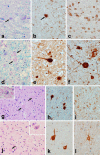Hereditary diffuse leukoencephalopathy with axonal spheroids (HDLS): a misdiagnosed disease entity
- PMID: 22050953
- PMCID: PMC3275663
- DOI: 10.1016/j.jns.2011.10.006
Hereditary diffuse leukoencephalopathy with axonal spheroids (HDLS): a misdiagnosed disease entity
Abstract
Hereditary diffuse leukoencephalopathy with spheroids (HDLS) was originally described in a large Swedish pedigree. Since then, 22 reports describing a total of 13 kindreds and 11 sporadic cases have been published. Inheritance is autosomal dominant, albeit the gene is unknown. Here we report on the clinical findings, genealogical data, brain MRI data, and autopsy/biopsy findings of four probands from three independently ascertained novel families from Norway, Germany and US. We identified a 39-year-old female and her twin sister, a 52-year-old male and a 47-year-old male with progressive neurological illness characterized by personality changes, cognitive decline and motor impairments, such as gait problems, bradykinesia, tremor and rigidity. Brain MRI showed white matter abnormalities with frontal prominence. Brain biopsy/autopsies were consistent with HDLS. HDLS is an under-recognized disease and in reporting these cases, we aim to increase the awareness of the disorder. Due to varied and wide phenotypic presentations, which may imitate several neurodegenerative diseases, HDLS can be difficult to diagnose. Definitive diagnosis can be established only by direct brain tissue examination. Familiarity with the clinical presentation and typical neuroimaging findings may be helpful in narrowing the diagnosis.
Copyright © 2011 Elsevier B.V. All rights reserved.
Figures



References
-
- Axelsson R, Roytta M, Sourander P, Akesson HO, Andersen O. Hereditary diffuse leucoencephalopathy with spheroids. Acta Psychiatr Scand Suppl. 1984;314:1–65. - PubMed
-
- Swerdlow RH, Miller BB, Lopes MB, Mandell JW, Wooten GF, Damgaard P. Autosomal dominant subcortical gliosis presenting as frontotemporal dementia. Neurology. 2009;72:260–7. - PubMed
-
- Mendes A, Pinto M, Vieira S, Castro L, Carpenter S. Adult-onset leukodystrophy with axonal spheroids. J Neurol Sci. 2010;297:40–5. - PubMed
Publication types
MeSH terms
Grants and funding
LinkOut - more resources
Full Text Sources

